
Print NW team members rely on their EFI Midmarket Print Suite workflow to meet or beat deadlines. Systems manager Troy Olsen says: “Before, it was too easy for things to fall off the radar”
A management information system (MIS) is rather like an airport control tower. It gives you an immediate and total overview of what is going out, what is coming in, where any potential bottlenecks might be, what needs putting into a ‘holding position’, what has been delayed, and what needs re-routing. Coupled with that, it gives you the power to respond quickly.
Imagine if everything in that control tower had to be done manually or relied on people’s memories. Translate that to your business production processes and you can see where I am coming from.
For most sign-makers and print suppliers, making the change from manual operation to software programmes is a fairly smooth transition which quickly results in streamlining of processes, increased productivity, and increased profitability. In fact, they very quickly wonder how they ever managed without it.
But, acting as devil’s advocate, I wondered—does MIS technology offer real benefits to everyone? So I checked in with a couple of software developers and some of the sign-makers and print suppliers who have put themselves in the ‘driving seat’.
Finger on the pulse
Global technology company, EFI, with headquarters in Silicon Valley, California, and offices around the world, including several UK locations, is well-known and respected for its development of technology designed to help businesses increase competitiveness.
Press relation manager, David Lindsay, is adamant: “MIS software is key to helping signage professionals grasp all of the pieces of information they perhaps were not effectively looking at or tracking before. So businesses that are not managing using their operations data now can only be better organised and more efficient with an MIS. And companies that do have a grasp of their data typically find that they can become even more efficient when they move to a more-integrated MIS platform that can automatically connect disparate aspects of the business.”

MIS software is key to helping signage professionals grasp all of the pieces of information they perhaps were not effectively looking at or tracking before”
And does size matter? Lindsay continues: “Certainly the need for an MIS becomes much more apparent once companies grow to a certain size, especially as they run into challenges tracking all the moving parts that come with building a signage production organisation.
“But smaller businesses can benefit as well from MIS to move beyond what they may be managing with a simple accounting or spreadsheet programme. However, the challenge for them is that the transition to an MIS should not create a significant disruption. For that reason, many small commercial printing operations use a cloud-based MIS offering from EFI that is simple to install.”
EFI has just launched Version 4 of its Midmarket Print Suite, which includes new features specifically designed to meet the needs of print-service-providers, as it addresses product-specific applications unique to the wide-format print space. These include fleet and vehicle wraps, point-of-purchase (POP) signage, and outdoor graphics. The enhanced capabilities in Midmarket Suite 4.0 also integrate with EFI Fiery digital front end systems for wide-format and super wide-format production.
The system also includes a ‘full request for quote dashboard’, that is designed to allow for quick and easy customer relationship management. The suite also features data tags for better filtering of results with specific signage characteristics related to substrate types and other factors, such as indoor or outdoor usage. A multiple object import tool also simplifies campaign management tasks such as recurring point-of-sale signage orders, which may vary in size and content across multiple locations of a chain store. These capabilities mean the technology has gained good traction across the world’s wide-format market.
Established in 2001, Print NW, with 165 employees, is among the largest printing companies in Washington State, and is a good case study example of this trend. Owners Jeffery Beardemphl, Ned Witting, and Jeff Stallings have built a dynamic and growing operation that constantly develops new products and services to meet customers’ changing needs. Although founded as an offset commercial printer and bindery, the company has now evolved to be a multi-channel manufacturing enterprise.
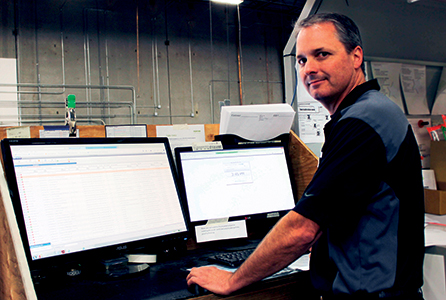
With EFI’s Pace Scheduler facility, Print NW now has greater visibility into its processes, with real-time data that helps them manage the business much more effectively and ensures they are meeting their on-time delivery promises
When Troy Olsen took over the role as systems manager at Print NW six years ago, he was tasked with ensuring that the company was getting the most out of its investments in MIS and other software systems. He discovered that the EFI Pace MIS the company was already using had not been fully implemented.
“I wanted to get up to speed quickly on what we could achieve with Pace,” says Olsen, adding: “My vision was to develop a seamless, end-to-end workflow that reduced costs and improved cycle time to ensure continuing competitive advantage. I was on a mission to use the tools that we had paid for and to embrace the technology we already had in place, and then to augment it to ensure that we stayed as competitive as possible.”
By working to integrate operations, Print NW has improved its service offering in a way that helped the company achieve faster growth. This has resulted in major operational changes that reflect Olsen’s embrace of automation and the support of company leadership.
“We have been able to more fully embrace our customers and give them better tools to do their jobs, reducing clicks and touches for them and for us,” explains Olsen.
The operational changes started with an upgrade to Print NW’s MIS, upgrading with an EFI Pace MIS workflow and eventually moving to a complete EFI Midmarket Print Suite that integrates Pace with a full range of components for end-to-end productivity.
Olsen notes: “Pace’s customisation features and application programming interfaces make it relatively easy to automate processes, define new fields and objects, create our own XML forms and connect to other systems. That openness has helped speed us toward achieving our vision.”
A key aspect of Print NW’s workflow is the use of Pace Scheduler. “It has been a pivotal part of what we have been able to accomplish,” says Olsen, adding: “Before, it was too easy for things to fall off the radar, or too difficult to get a good overview of exactly how jobs were being managed throughout the plant. We couldn’t capture data from the operator’s perspective, easily do cost analyses, or see cost versus estimate in a holistic way. Now we have great visibility into the process with real-time data that helps us manage the business much more effectively and ensures we are meeting our on-time delivery promises.”
Pace Scheduler is essential to Print NW keeping up its print volumes—as the amount of work the company does would be next to impossible to manage with a manual scheduling board.
Olsen continues: “Besides, with the speed of our business today, by the time I could put a job on a manual board, it is likely already produced. And because of the efficient, integrated workflow we have with the Productivity Suite, we are already able to process double the work with the same number of people while achieving better turnaround times.”
Olsen says that working with EFI to ensure the best results by taking a big picture view of the workflow and future needs is important as well: “This is a movie, not a snapshot. It is a system that is continually changing as our needs and requirements, and those of our customers, change.”
Once that ‘movie’ started playing with the company’s Midmarket Print Suite in place, Print NW managers were excited about what they saw. Olsen’s team programmed a number of queries into the system that provided his team with data it uses to create customised quarterly, monthly, and weekly reports for managers. By managing processes, and tracking and analysing data, they found that they could not only do more with the same production resources, they could reduce expenses in ways that keep the company highly competitive in the marketplace.
“The data and reporting help our managers make informed decisions,” Olsen comments, adding: “So we continue to reduce waste and costs, passing some of those savings on to our customers. And while we had an e-Commerce system before with a number of customer storefronts established, we believe the Digital StoreFront integration into the overall EFI workflow will offer significantly improved productivity.”
A clear view
Since its inception in 2001, West Midlands based Clarity Software, a division of Touch Systems, has developed hundreds of successful MIS and customer relationship management (CRM) systems for SMEs in digital print, sign-making, and graphic display. Like EFI, it has experienced a sharp uptake in demand from its systems as sign-makers and wide-format print specialists have begun to struggle with the logisitics of quoting, processing, scheduling, and invoicing for large numbers of customers that each have very bespoke needs. As such, users of Clarity’s software range from start-ups with just one or two employees up to 100 plus employee organisations with bespoke operational processes.
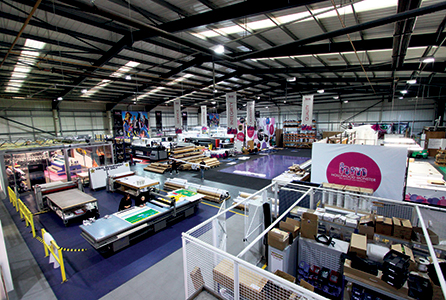
Hollywood Monster’s extensive production workshop; Clarity Software’s solutions enable the company to integrate the different elements within its business function by enabling them to have real time data on the progress of projects
The overall objective of MIS, says Clarity, is to create a joined up system that requires the minimum of human input to produce the maximum visibility and decision making power. There is no minimum size requirement in order for a business to derive benefit from installing a MIS.
Among Clarity’s many UK customers are Hollywood Monster, The Sign Group, and Signbox. Ian Halford, quality manager at Birmingham based Hollywood Monster, comments: “The Clarity software platform, has proven to be useful for us as it integrates the different elements within our business function, from Customer Relationship Management to procurement, manufacturing and aftersales, thereby supporting our customers by enabling us to have real time data on the progress of projects from concept through delivery.
“Within this platform we are able have the transparency of each individual project, from the stage at which the project is within the manufacturing process, to the costing and strategic market data that we can extract.”
Leeds company The Sign Group says that its Clarity software does exactly what it needs it to do. “It’s incredibly useful; it’s invaluable to us,” says director, Graeme Hoole, adding: “We have nine people using it constantly throughout the day, every day. We can find a quote from ten years ago as quickly as one from yesterday using various search methods, which is handy when doing repeat work in order to check what was done previously and to help with consistency and pricing.
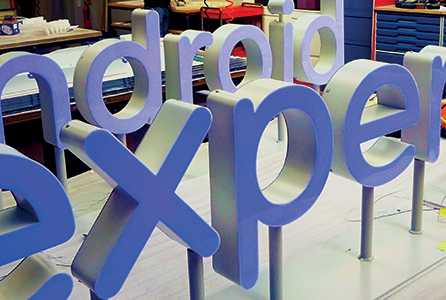
Built-up, rimless stainless steel letters with acrylic faces, fixed to a steel base, manufactured by The Sign Group, which quotes each job individually using Clarity Software’s solutions
“The internal pricelists that are used to create customer quotes are like a goldmine of information. Assuming it’s kept up to date, which is easy to check, quotes can be turned round for existing customers within one to two minutes flat. When you’re trying to get through 100 to 200 quotes per day, you need this system in place to stop you from getting swamped.”
The Sign Group does not have printed price lists for built up letters in different sizes, preferring to quote each job individually and Hoole explains: “Without Clarity this would be a pain and we would have to fall into the trap of having written lists but because we quote each job separately customers can be sure they are getting our keenest price, not an ‘off the cuff’ guess.”
O Factoid: The first airport traffic control tower, regulating arrivals, departures, and surface movement of aircraft at a specific airport, opened in Cleveland, Ohio in 1930. Approach/departure control facilities were created after the adoption of radar in the 1950s to monitor and control the busy airspace around larger airports. O
Architectural signage solutions specialist, Signbox in Oldham, has been designing and manufacturing architectural and other signage products for the built environment in the UK and overseas for 30 years. When general manager, Brett Bailey, was looking for an industry-specific MIS that would help the business speed up its day-to-day process from start to finish, he also looked for a system that would help to save administration time. Clarity Professional was chosen as it is specialised for his business.
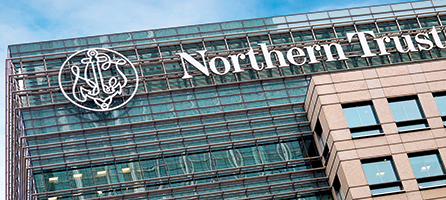
Architectural signage solutions specialist, Signbox in Oldham, has been manufacturing architectural and other signage products for the built environment in the UK and overseas for 30 years
“Everyone in the business knows how to use Clarity, which has helped speed up the whole process from quoting, to job sheets, to invoicing, making the process pain free,” explains Bailey, adding: “The consistency in pricing that can be achieved with the price list facility and the ability to check the value of the order book are great features within the system. Clarity is a CRM, admin and financial management tool all in one package.
“After implementing the system in 2007 we were able to increase gross profit throughout the recession by accurate job costing and analysing margins. I would most definitely recommend Clarity to other businesses.”
An alternative route
In contrast to the above ‘off-the-shelf route’, Essex based Venture Banners took the alternative route of creating and developing its own MIS in-house.
Sales and marketing director, Scott Conway, provides the background: “We typically process somewhere in the region of 1,600 separate orders each month comprising of over 10,000 individual print products so a decent MIS system is absolutely essential for our business. Our Vuteks can print close to 200sq m/h of print each, and it’s no use having the ability to print that volume of work if you have no way of collating and completing the resultant formalities.
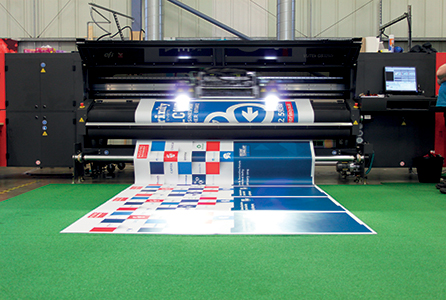
Venture Banners’ Vuteks can print close to 200sq m/h. Sales and marketing director Scott Conway says: “It’s no use having the ability to print that volume of work if you have no way of collating and completing the resultant formalities”
“Designed and built in-house, our MIS is our workflow system, our customer relationship management system and our business measurement system. It accesses and displays information from our accounts software and also acts as stock management for our product and substrate range.”
The system is used in every part of the business, and the company has a large monitor in the production area showing the number of jobs and the material split for each day, giving the production team all the information they need to manage their own workflow. The system even uses QR codes to integrate into Venture Banners’ TNT shipping system in order to streamline its despatch process.
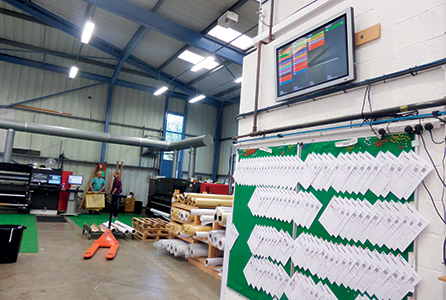
Venture Banners’ production volumes screen with job cards for the day’s jobs. The company typically processes somewhere in the region of 1,600 separate orders each month
“About 70 percent of our orders are completed online and the system communicates with our trade website, taking and handling all of the online orders, processing the orders through the sales process to the studio where the artwork is processed prior to it being RIP’d and printed,” continues Conway, adding: “I think it’s safe to say that if we had to run around the building with job bags like the ‘old days’, we would fall over pretty quickly.”
Hazard check
I could not resist asking whether there were any drawbacks to installing a MIS. Hollywood Monster’s Halford was adamant that that the company had not experienced any drawbacks: “We haven’t really found any drawbacks on the software’s platform, as this has been developed in conjunction with the Clarity team to meet the needs of our business.”
However, The Sign Group’s Hoole adds a word of advice: “Not that it’s a drawback, but the information you get out of it is only as good as the info you put in. If it’s the first time you’ve used a system like this, it will more than likely lead to a different approach in how you quote, organise jobs and purchase products. Not a bad thing, just something to bear in mind.”

If it’s the first time you’ve used a system like this, it will more than likely lead to a different approach in how you quote, organise jobs and purchase products”
Overall the general consensus is that the control, productivity, and profitability benefits that can be achieved with a MIS far outweigh any minor teething problems that may occur. However, it is always wise to ensure that the product you choose is designed to meet your specific business and production process requirements by choosing a reputable manufacturer that is experienced in creating industry specific solutions.
Your text here...